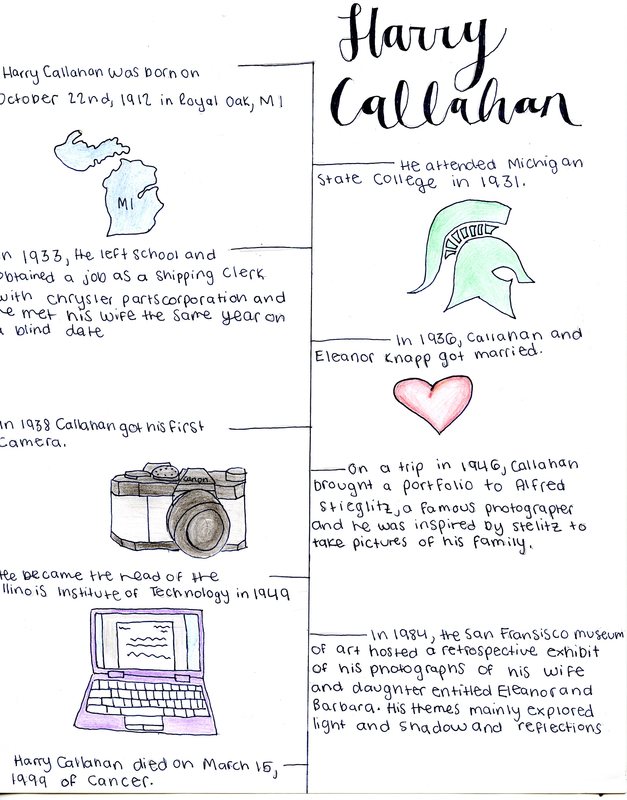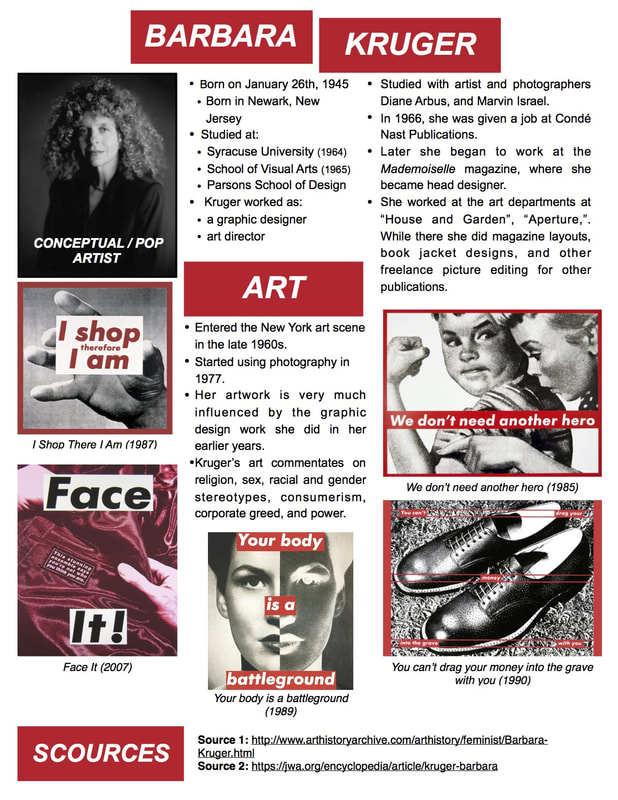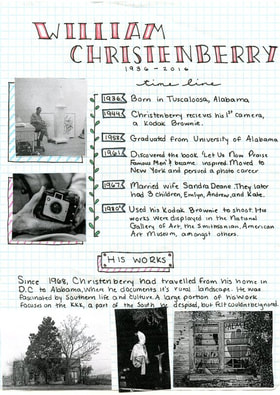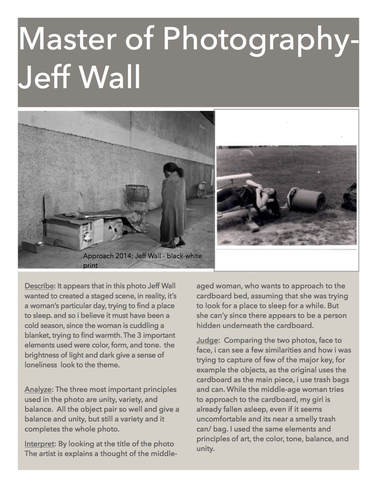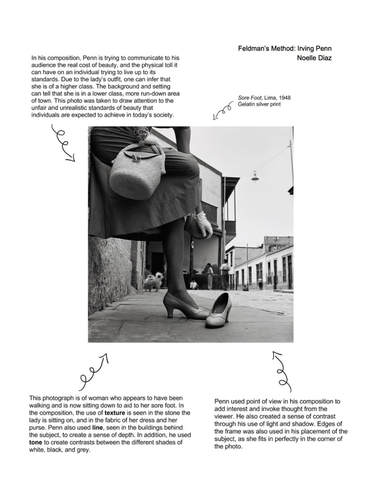The Objective
Research and analyze the work of a master photographer in order to understand the techniques, concepts, and themes they explore. You will demonstrate your understanding by analyzing a photography by your artist, identifying techniques and concepts within that work and shooting a roll of film following the same objectives, creating a presentation consisting of a PowerPoint and a digital handout to be used in class based on the life and work of your master photographer.
The Handout (50 Points - Due 4/25)
Create a handout about your chosen master photographer. Include enough images to make it informative, eye-catching, and legible. Label each image with the date and title. Try to keep it neatly designed and organized. This can be used later in conjunction with your PowerPoint presentation.
On the page, include a timeline for your photographer of important dates pertaining to: their birth, education, where they lived, relationships or art movements, exhibitions, other world events that are important to their time, and death (if applicable).
Include what themes this artist explores in their work (time, the human form, street life, family, nature, etc.) Include historical information about your photographer, how they got into photography, what they are known for or have contributed to photography, maybe quotes from the artist. All sources need to be cited with he book or article title, or the website address.
This handout can be created by hand and scanned in, through Photoshop, Pages, or any other similar application. Just keep to the standard printer size (8x10).
On the page, include a timeline for your photographer of important dates pertaining to: their birth, education, where they lived, relationships or art movements, exhibitions, other world events that are important to their time, and death (if applicable).
Include what themes this artist explores in their work (time, the human form, street life, family, nature, etc.) Include historical information about your photographer, how they got into photography, what they are known for or have contributed to photography, maybe quotes from the artist. All sources need to be cited with he book or article title, or the website address.
This handout can be created by hand and scanned in, through Photoshop, Pages, or any other similar application. Just keep to the standard printer size (8x10).
The Feldman's Method (65 Points - Due 5/9)
Either in your sketchbook, binder, or digitally, complete an artful and creative arrangement that explores and analyzes one work by your master photographer. The work you choose should represent what interests you in your master’s work. Use Feldman’s Method to Describe, Analyze, Interpret, and Judge the work. It could take the form of a diagram, a collage, a pop-up book, a brochure, an advertisement, etc. Have fun with it!
You should include:
A clear reproduction of the artwork you are analyzing as a central element, the title, date, the artist’s name, and the medium (what kind of photo process was it?)
For each response, give specific examples from the artwork, be as detailed as possible and explain why you came to the conclusion you did.
Describe (10 points): Physically describe the photograph. What are the 3 most important elements of art used?
Analyze (10 points): What are the 3 most important principles of composition? (How are the elements of art used in the composition? What compositional elements have been used?
Interpret (10 points): How is the artist communicating? What themes or meanings is the photographer exploring? Why was this photo taken? How does the technique or composition of the photographer? Support their ideas? (Take into account all of your research.)
Judge (25 points): On a new page, attach a copy of one of your prints (make an extra one) and compare its elements and principles, and meaning to the master one. You will do this section AFTER you have shot a roll in their style where you will compare a photo of yours to their work.
Creative Presentation (10 points)
You should include:
A clear reproduction of the artwork you are analyzing as a central element, the title, date, the artist’s name, and the medium (what kind of photo process was it?)
For each response, give specific examples from the artwork, be as detailed as possible and explain why you came to the conclusion you did.
Describe (10 points): Physically describe the photograph. What are the 3 most important elements of art used?
Analyze (10 points): What are the 3 most important principles of composition? (How are the elements of art used in the composition? What compositional elements have been used?
Interpret (10 points): How is the artist communicating? What themes or meanings is the photographer exploring? Why was this photo taken? How does the technique or composition of the photographer? Support their ideas? (Take into account all of your research.)
Judge (25 points): On a new page, attach a copy of one of your prints (make an extra one) and compare its elements and principles, and meaning to the master one. You will do this section AFTER you have shot a roll in their style where you will compare a photo of yours to their work.
Creative Presentation (10 points)
The Roll (100 Points - Due 5/9)
Shoot a roll of film in the style of your master photographer. Consider the techniques they have used and the themes, concepts, or ideas they explore in their work. Pay close attention to their subject, lighting situation, and mood. You will create a rubric on your own that will explain what your objective will be based on the work of your master photographer. You will turn in this rubric along with you 3 best prints.
The Presentation (50 Points - Due 5/9)
After you are finished the handout you will give a presentation on your photographer. You will also need to submit a presentation. This can be done in PowerPoint, Keynote, Prezi, any other similar digital application or through handmade visuals. You will use your handout as part of your presentation. Your presentation should:
- be interesting to watch
- include images by the photographer, of the photographer if possible, and of the time period if necessary
- include elements from your timeline to highlight important events in the artist’s life
- discuss the photographer themes, ideas, subject matter, technique
- INCLUDE your 3 best prints (scanned from the negatives) that embody your photographer’s style in the presentation to discuss how you interpreted their style.
|
4A_TanvirGrewal by aborleis on Scribd |
4B_SamiraToure by aborleis on Scribd |
The Photographers (No Duplicates - First Come First Serve)
You may not select one that is being done by someone else in class. Research the artist using a variety of sources. PLEASE MAKE SURE YOUR SOURCES ARE RELIABLE. NO WIKI ARTICLES!
http://masters-of-photography.com is a good place to start to see many examples of work. There is also a slide show located on the class website.
http://masters-of-photography.com is a good place to start to see many examples of work. There is also a slide show located on the class website.
|
Berenice Abbott
Ansel Adams Diane Arbus Eugene Atget Richard Avedon Richard Barnes Bernd & Hilla Becher Karl Blossfeldt Bill Brandt Margaret Bourke-White Wynn Bullock Harry Callahan Henri Cartier-Bresson William Christenberry John Coplans Imogen Cunningham Gregory Crewdson Robert Doisneau William Eggleston |
Elliott Erwitt
Walker Evans Robert Frank Lee Friedlander Jan Groover John Gutman Andreas Gursky Ernst Haas André Kertész William Klein Josef Koudelka Barbara Kruger Dorothea Lange Clarence John Laughlin Annie Leibovitz Helen Levitt Sally Mann Mary Ellen Mark Ralph Eugene Meatyard |
Duane Michaels
Lisette Model Tina Modotti Abelardo Morell Eadweard Muybridge James Nachtwey Arnold Newman Paul Outerbridge Robert & Shana ParkHarisson Gordan Parks Irving Penn Man Ray Sabastião Salgado Victor Shrager Cindy Sherman Aaron Siskind Sandy Sköglund Mike & Doug Starn Edward Steichen Alfred Stieglitz |
Joel Sternfeld
Paul Strand Josef Sudek Hiroshi Sugimoto George Tice Jerry Uelsmann Jeff Wall Weegee (Arther Fellig) Edward Weston Minor White Garry Winogrand Francesca Woodman |
